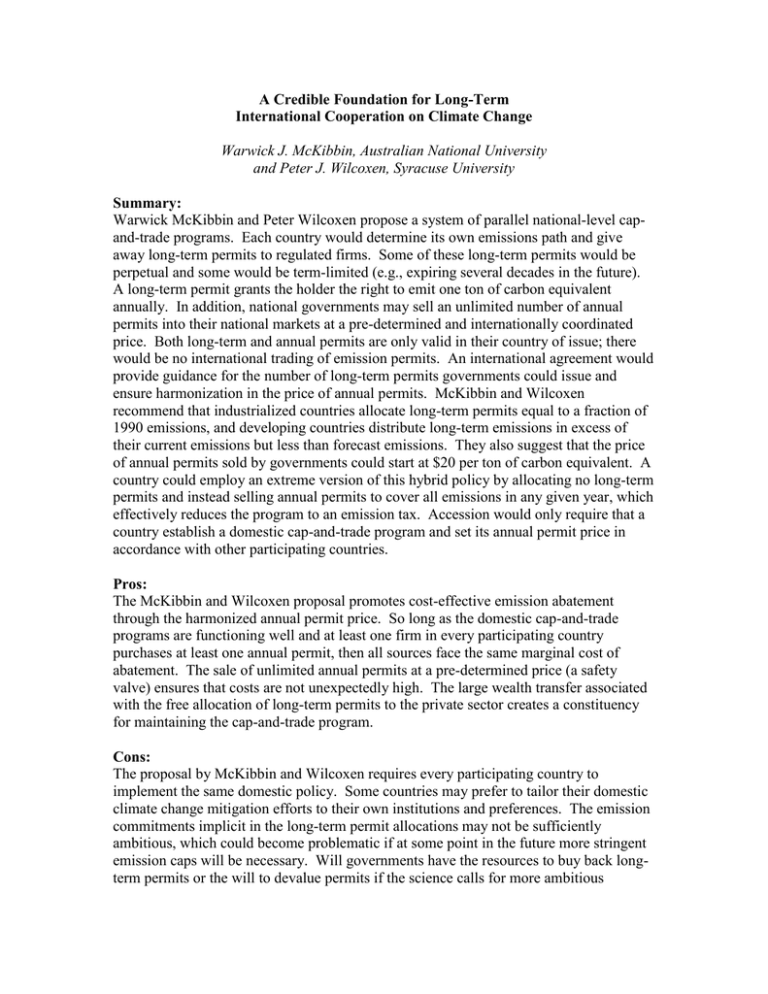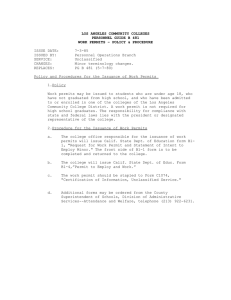A Credible Foundation for Long-Term International Cooperation on Climate Change Summary:
advertisement

A Credible Foundation for Long-Term International Cooperation on Climate Change Warwick J. McKibbin, Australian National University and Peter J. Wilcoxen, Syracuse University Summary: Warwick McKibbin and Peter Wilcoxen propose a system of parallel national-level capand-trade programs. Each country would determine its own emissions path and give away long-term permits to regulated firms. Some of these long-term permits would be perpetual and some would be term-limited (e.g., expiring several decades in the future). A long-term permit grants the holder the right to emit one ton of carbon equivalent annually. In addition, national governments may sell an unlimited number of annual permits into their national markets at a pre-determined and internationally coordinated price. Both long-term and annual permits are only valid in their country of issue; there would be no international trading of emission permits. An international agreement would provide guidance for the number of long-term permits governments could issue and ensure harmonization in the price of annual permits. McKibbin and Wilcoxen recommend that industrialized countries allocate long-term permits equal to a fraction of 1990 emissions, and developing countries distribute long-term emissions in excess of their current emissions but less than forecast emissions. They also suggest that the price of annual permits sold by governments could start at $20 per ton of carbon equivalent. A country could employ an extreme version of this hybrid policy by allocating no long-term permits and instead selling annual permits to cover all emissions in any given year, which effectively reduces the program to an emission tax. Accession would only require that a country establish a domestic cap-and-trade program and set its annual permit price in accordance with other participating countries. Pros: The McKibbin and Wilcoxen proposal promotes cost-effective emission abatement through the harmonized annual permit price. So long as the domestic cap-and-trade programs are functioning well and at least one firm in every participating country purchases at least one annual permit, then all sources face the same marginal cost of abatement. The sale of unlimited annual permits at a pre-determined price (a safety valve) ensures that costs are not unexpectedly high. The large wealth transfer associated with the free allocation of long-term permits to the private sector creates a constituency for maintaining the cap-and-trade program. Cons: The proposal by McKibbin and Wilcoxen requires every participating country to implement the same domestic policy. Some countries may prefer to tailor their domestic climate change mitigation efforts to their own institutions and preferences. The emission commitments implicit in the long-term permit allocations may not be sufficiently ambitious, which could become problematic if at some point in the future more stringent emission caps will be necessary. Will governments have the resources to buy back longterm permits or the will to devalue permits if the science calls for more ambitious mitigation efforts? The proposal also may not provide sufficient incentives for developing country participation. The prohibition on international emission trading eliminates the gains from trade in emission permits that could entice such participation.




